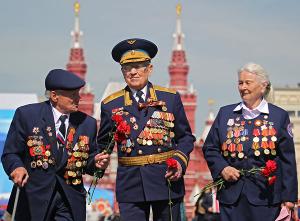Staunton, May 9 – The “chief cause” of the collapse of the Soviet Union in 1991 was Stalin’s occupation of the Baltic countries, Western Ukraine, Western Belarus and Bessarabia, thus making what the Russian Federation celebrates today as a resounding triumph into “a Pyrrhic victory” for the country, according to a Russian blogger.
In a blog post reposted on the Ekho Moskvy portal, Russian businessman Aleksey Blindul says that “the chief cause which destroyed the Soviet empire was the occupation” or, as some call it, the “’liberation’” of these border areas (ablindul.livejournal.com/67788.htm repeated at echo.msk.ru/blog/ablindul/1070390-echo/).
As one of the winners in World War II, the USSR insisted on retaining not only the territories it had occupied earlier during that conflict, including Estonia, Latvia and Lithuania, portions of Poland, and part of Finland but also the northern portion of East Prussia which it renamed Kaliningrad.
Poland was compensated with German territory in the west, Blindul writes, and part of the territories the USSR had acquired – Eastern Prussia and the segment of Karelia – “were liberated from the local population and peopled with resettlers from other regions of the Soviet Union.”
But there was no place to send “the millions of Estonians, Lithuanians, Latvians, Ukrainians, Belarusians and Moldovans,” although of course many were deported to Siberia, he says, and consequently, they were “folded into the Soviet family.” That became “a death sentence” for the Soviet Union.
The reason for that conclusion, he writes, is that these “new Soviet citizens had lived two decades in relatively free countries” or at least had not experienced “the collectivization and repressions of the 1930s” in Stalin’s Soviet Union.
“Tens of millions of these people who lived on the occupied territories and their progeny even over the course of the post-war repression and a half century of propaganda did not become Soviet citizens.” They only awaited their chance and with the weakening of the Soviet center at the end of the 1980s, they took it.
“The peoples fronts in the Baltic republics, the Romanian nationalists in Moldova, the Ukrainian nationalists from Rukh and the Belarusian Popular Front, drawing on the support of the population in the western sections of the republic, Blindul writes, “began a struggle for independence, and after a couple of years, this ended with the destruction of the Soviet Union.”
(Because it had removed the local population from East Prussia and the part of Finland it had seized, the Soviet Union did not face the same challenges from these two places, the blogger rights. But those places, which had been wealthy segments of European countries before 1939 were transformed into areas resembling “the depressed Non-Chernozem” region of Russia.)
Had Stalin limited his imperial ambitions to what the Soviet Union already possessed in its 1939 borders, Blindul argues, “this state would exist even now,” except perhaps for union republics in the Trans-Caucasus whose populations also had a brief but earlier experience as independent countries
Moscow’s ‘Pyrrhic Victory’ in 1945 Led to Soviet Collapse in 1991 (1)
Viimased kommentaarid
Kommentaarid on kirjutatud EWR lugejate poolt. Nende sisu ei pruugi ühtida EWR toimetuse seisukohtadega.
http://www.whale.to/b/hitler.h...
Hitler was trained at Tavistock, and was in GB for 3 years.
http://mailstar.net/sutton.htm...
Dear Mr. President:
I am in sympathy with the Soviet form of government as that best suited for the Russian people...
Letter to President Woodrow Wilson (October 17, 1918) from William Lawrence Saunders, chairman, Ingersoll-Rand Corp.; director, American International Corp.; and deputy chairman, Federal Reserve Bank of New York.
Hitler was trained at Tavistock, and was in GB for 3 years.
http://mailstar.net/sutton.htm...
Dear Mr. President:
I am in sympathy with the Soviet form of government as that best suited for the Russian people...
Letter to President Woodrow Wilson (October 17, 1918) from William Lawrence Saunders, chairman, Ingersoll-Rand Corp.; director, American International Corp.; and deputy chairman, Federal Reserve Bank of New York.
Arvamus
TRENDING

























